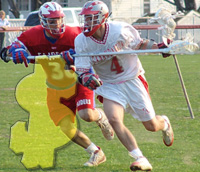
Lacrosse Scholarships
September 8, 2011 - Back in February of 2007, Coach Wilson posted a blog story called "Doing The Scholarship Math". The article pointed out the somewhat often misconception that scholarships in lacrosse were easy to find and get. In fact, the story demonstrated that a player would need to be among the top two percent of players to receive, in most cases, a partial scholarship.
The article pointed out the somewhat often misconception that scholarships in lacrosse were easy to find and get. In fact, the story demonstrated that a player would need to be among the top two percent of players to receive, in most cases, a partial scholarship.
Since 2007, the number of lacrosse teams at both the High School and College levels have increased greatly. Reports by the NCAA and the National Federation of High School Athletic Association showed in 2011 a growth of (226 to 262 team in college) and (1,588 to 2,192 teams in high school) in the period from 2007 to 2010. In the twenty-five years from 1985 to 2010 the number of college teams grew from 144 to 262 (82%) and the number of high school team increased from 488 to 2,068 (324%).
So, with the large increases it is time to review the math.
Thar's money on them thar fields (or not) . . . .
I can't count the number of times that I have heard players (and their parents) talk about how hard they are working in the hopes of securing a college lacrosse scholarship. The subject often comes up at the end of a season, after a player has done well in his varsity season (and often earlier), and plans are underway to select "the right strategies" in an effort to increase college exposure.
Well, let's look at the numbers and see what's available.
We should start with the premise that the potential player is athletic, accomplished and among the  best on his team and well respected within his league and Section.
best on his team and well respected within his league and Section.
The NCAA allows a maximum of 12.6 full scholarships per team at any one time. That's 12.6 for the whole team (freshman year through senior years). Making the math simple, that would mean that a "fully funded" Division I team would have about 3 full scholarships (maximum) for each recruiting class.
To be realistic, however, it should be noted that most Division I teams are not fully funded, meaning that they do not offer the full 12.6 scholarships. It should also be noted that most scholarship offers are not "full rides", but are partial scholarships, allowing for more team members to get "some" athletic aid if warranted.
Back to the math . . .
The NCAA lists 60 Division I schools playing lacrosse (2011). Seven schools are in the Ivy League (which do not allow athletic scholarships), which leaves us with 53 teams that could offer up to 3 scholarships to recruits.
Based on our "simple math" we could conclude that there would be less than 159 scholarships available to a recruiting class in Division I in a given year.
At the Division II level, the NCAA allows 10.8 scholarships per team and the NCAA lists 41 teams playing. Using the same math, there would be less than 110 scholarships available for the Division II recruiting class.
Division III and club teams are not allowed to offer athletic scholarships.
Now, let's look at the "player pool".
 In the 2011 season in Section V, there were 410 seniors playing lacrosse on 36 teams, an average of 11.4. The NFHSAA lists 2,068 schools playing high school lacrosse (2011). If we conservatively estimate 11 seniors on each team, that would mean that 22,748 players might be interested in playing at the college level.
In the 2011 season in Section V, there were 410 seniors playing lacrosse on 36 teams, an average of 11.4. The NFHSAA lists 2,068 schools playing high school lacrosse (2011). If we conservatively estimate 11 seniors on each team, that would mean that 22,748 players might be interested in playing at the college level.
If just the top 2 percent of those seniors are looking for a scholarship that would mean that almost 455 players are competing for 159 D-I and 110 D-II slots.
In reality, those top 2 percent of seniors (and perhaps a few more) would be splitting partial scholarships. If each of the 101 teams (D1 and D2) is looking for 10 recruits per year (including both scholarship and non-scholarship athletes), there would be about 1,010 lacrosse positions available in a recruiting year, so just making the team would be an accomplishment.
In fact, if D3, without scholarships, is also considered, there would be about 277 teams looking for ten players each for a total of 2,770 potential player spots each year. With 22,748 seniors, the chances of playing on any team would be 1 out of 8. Simply, on an average basis in our model, about one player per high school team would play on any college team. Obviously, some of the top teams in the country will place a number of college players and many more teams will have none.
Now, lets take a moment to look at what a partial scholarship looks like. The NCAA reports that (in  2010) the average D1 team had 46 players on the team. With 12.6 "full scholarships" available to a fully-funded program, if each player on the team had an equal share, each player would receive about a 25% scholarship. In reality, however, some players receive more money than others and there are many D1/D2 players who play on the team and receive no athletic scholarships.
2010) the average D1 team had 46 players on the team. With 12.6 "full scholarships" available to a fully-funded program, if each player on the team had an equal share, each player would receive about a 25% scholarship. In reality, however, some players receive more money than others and there are many D1/D2 players who play on the team and receive no athletic scholarships.
In the real world, with four year college costs between $24,000 and $240,000 a twenty-five percent scholarship still leaves a whole lot more to be funded.
Thinking about going after a college lacrosse scholarship? Are you in the top two percent of your team, league and section? Perhaps you should work on your grades and look for an academic scholarship. They are "easier" to get, but that math lesson is for another day.




